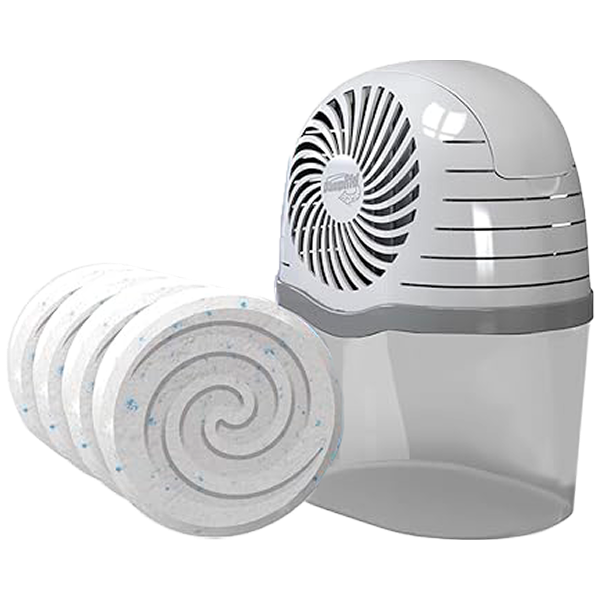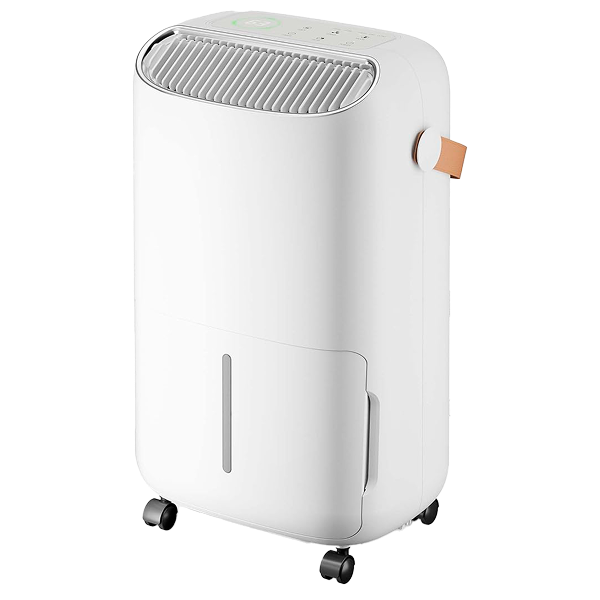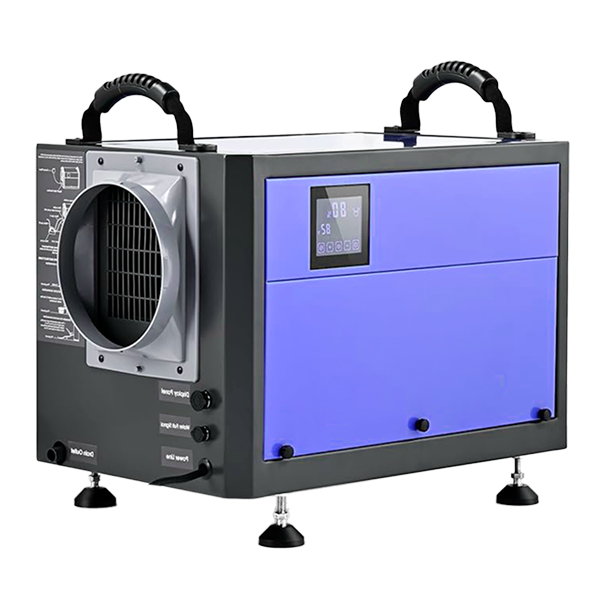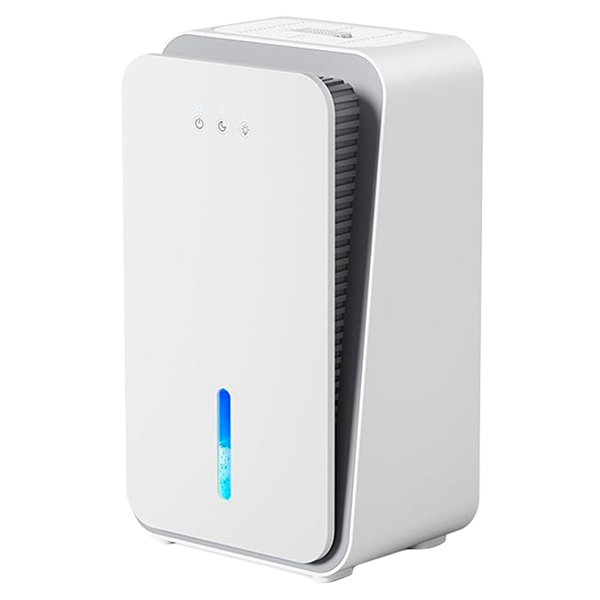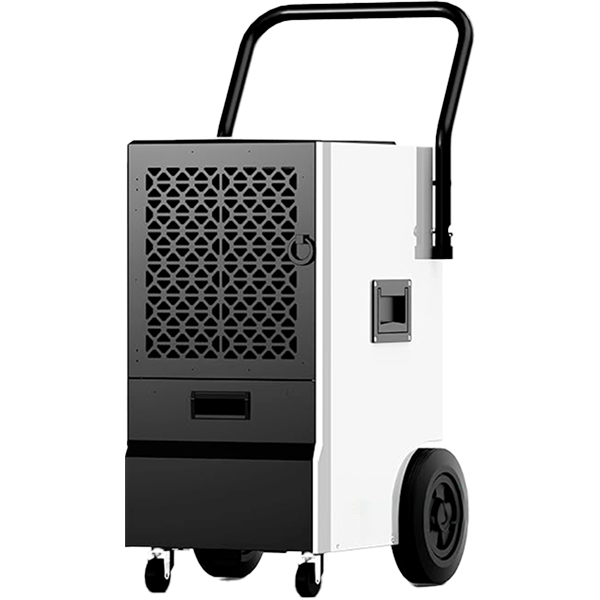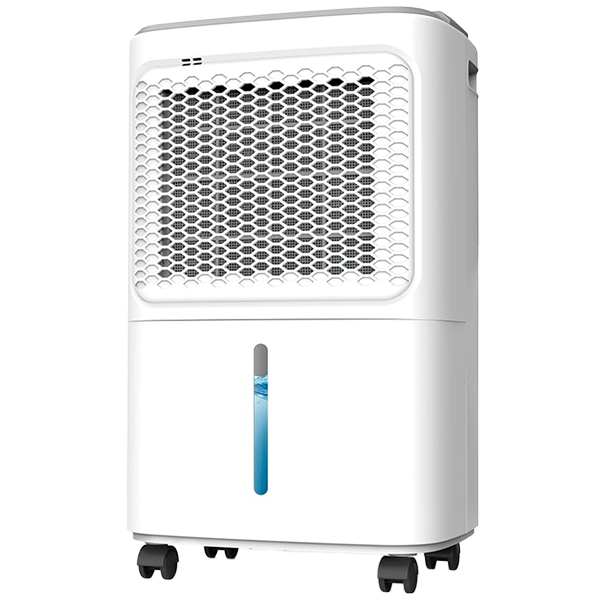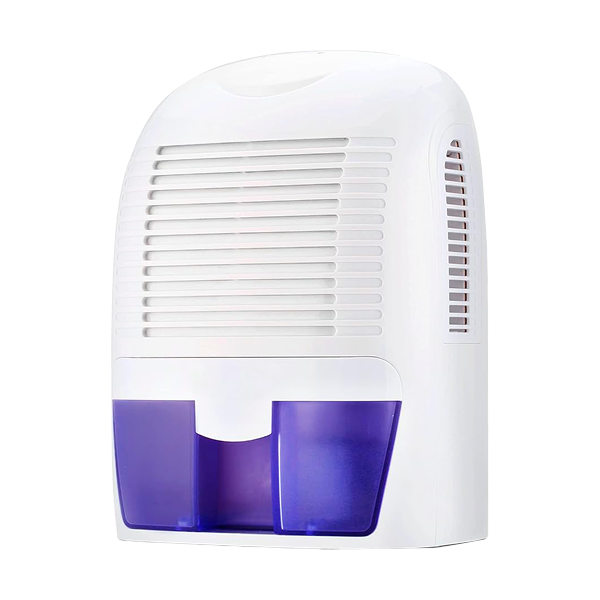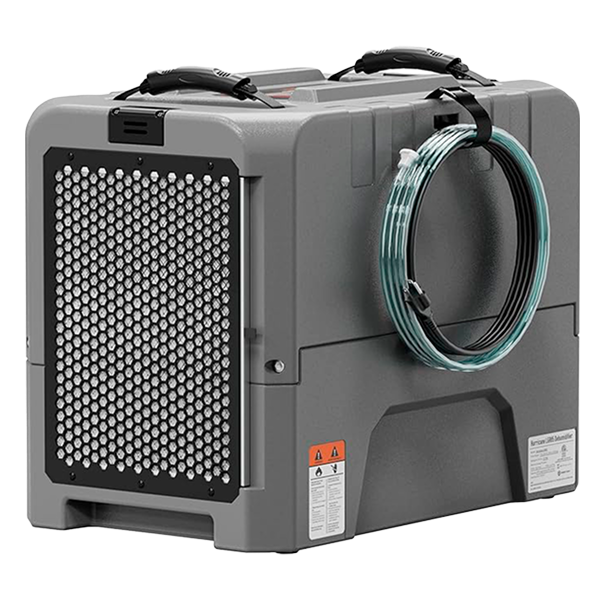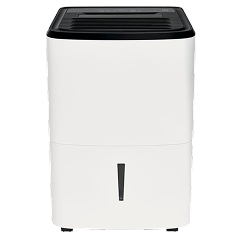Compressor dehumidifiers, also known as refrigerant dehumidifiers, work by drawing in room air and passing it over a filter and ice-cold coils. As the coils cool, water condenses and drips into the unit’s bucket. The air is reheated to room temperature, and dry, filtered air is blown back out. Compressor dehumidifiers are among the most common types, particularly for domestic use. In this guide, we’ll explain what to look for when buying, review popular manufacturers, and help you choose a unit best suited for your space and needs.
Moisture Extraction (L/24 h)
This indicates the amount of moisture the device can remove from the air in a 24-hour period. Smaller units remove 10–12L/day, while larger ones can handle over 20L/day. Choose the right one based on your room size and how damp the space is.
- <10L/day – This is a standard moisture extraction rate for compact units, best for small rooms such as studies, children’s bedrooms, storage rooms, light condensation, or mild damp.
- 10–20L/day – Most compressor dehumidifiers on the market will have a moisture extraction of this range. These models are ideal for bedrooms, living rooms, and flats with noticeable humidity.
- 20L+/day – High-capacity machines suited for large spaces, heavy damp, laundry drying, or leaks. Recommended for multiple-story houses, offices and open-plan spaces.
If your home struggles with persistent condensation, mould, or musty smells, choose a higher extraction capacity for faster results.
Coverage Area (m²)
Always check if the model you’re considering is powerful enough for your intended room size. Consider whether your space is open-plan and if the dehumidifier will be powerful enough to get into hidden spots and crannies.
- <20 m² – Best for small bedrooms, bathrooms, or studies.
- 20–40 m² – Good for standard bedrooms, kitchens, or medium-sized living rooms.
- 40 m²+ – Suitable for large lounges, basements, or open-plan homes.
Energy Efficiency Ratio (EER)
EER shows how effectively the dehumidifier turns electricity into moisture removal. The higher the rating, the less energy it wastes. This also dictates how much you’re going to spend on energy bills, and it’s an important feature to consider before buying.
- <1.5 – Less efficient. Likely higher running costs.
- 1.5–2 – Average efficiency, suitable for most households.
- >2 – Highly efficient. Better long-term savings on bills.
Tank Capacity
The water collected from the air is stored in a built-in tank. A larger tank means fewer trips to empty it, but it also takes up more space.
- <2L – Needs daily emptying if used regularly. Fine for small bedrooms, nurseries or short-term use.
- 2–4L – A balanced option for most homes, offering convenience without excess bulk.
- >4L – Suited for continuous operation in damp homes. Great for busy households.
Some models offer continuous drainage for non-stop operation without manual emptying.
Noise Level & Noise Preference (dB)
Dehumidifiers aren’t silent, and you should always expect some noise, like with a dishwasher or fan. Choose according to your intended use:
- <40 dB – Super Quiet: Barely noticeable, ideal for nurseries, bedrooms, or study spaces.
- 40–50 dB – Quiet: Similar to rainfall, fine for living rooms and kitchens.
- >50 dB – Moderate/Noisy: Noticeable hum, best for basements, utility rooms, or daytime-only use.
Look for sleep/night mode if you intend to use your dehumidifier in the bedroom.
Continuous Drainage Option
A continuous drainage hose is useful if you want to set and forget your dehumidifier. Using a drainage hose lets you run the dehumidifier non-stop, with water flowing into a drain or large collection tank.
Humidistat
This feature lets you set a target humidity level. Once the level is reached, the dehumidifier will turn off automatically and restart only when the humidity rises again, conserving energy and preventing over-drying.
- Manual Dial – Budget-friendly and easy to use.
- Digital Display – More precise, often shows current humidity and allows for one-touch adjustments.
Smart/App Connectivity & App Features
Wi-Fi-enabled models allow remote control via smartphone apps. Some models also support voice control, letting you use Alexa or other smart assistants to set the dehumidifier hands-free.
Most common app functions include:
Portability Features
If you’re planning to move your dehumidifier around, consider whether it has wheels, carry handles and lightweight components. Choose ergonomic designs for transporting between rooms and storing the unit away when not in use. Small details such as a cable tidy might come in handy too.
Modes & Functions
While the main goal of a dehumidifier is to suck moisture from the air and make your room less humid, many come with use-specific modes. These often include:
Traffic Light Humidity Sensors
Some dehumidifiers come with a traffic light humidity indicator, a simple but useful visual feature that shows current humidity levels at a glance. These sensors use coloured lights – typically green, amber, and red – to indicate whether the humidity is ideal, slightly high, or too high.
- Green = Ideal humidity (usually between 40–60%)
- Amber = Moderate humidity (may feel stuffy or damp)
- Red = High humidity (risk of mould, condensation, or musty smells)
Aesthetics (Design, Color & Size)
There’s a model for every space, whether integrated or portable. Modern dehumidifiers come in neutral tones like white, grey, or soft pastels, with various shapes, LED lights, and sleek details that blend into living spaces. Some feature smooth edges, glass tanks, glossy finishes, or minimalist designs. Choose a model that complements your style, from Scandi minimalism to playful kid’s-room options.
Operating Temperature Range
Most compressor dehumidifiers operate at a temperature between 5–35 °C. However, some high-tech models might support colder and warmer climates too. Always double-check the unit’s operating temperature based on the intended room use.
- Standard Range (15–35°C) – This is the standard operating temperature for dehumidifiers. Ideal for most home environments.
- Cold-Ready Models (<10°C) – These may feature auto-defrost or use desiccant technology. Perfect for basements, garages, or unheated conservatories.
For cooler rooms with constant temperature below 15°C, choose models with an auto-defrost function or opt for larger, desiccant models (cold garages and basements).
Filter Type
Most compressor dehumidifiers come with built-in filters to trap dust, allergens, and impurities before air is released into the room. Filter type affects both maintenance and air quality:
- Washable Mesh Filter – Standard in most models. Easy to clean, reusable, and keeps dust out of the coils.
- HEPA Filter – Captures fine particles and allergens. Ideal for asthma sufferers or allergy concerns.
- Activated Charcoal / Carbon Filter – Neutralises odours and traps gases, making it great for kitchens, basements, or damp-smelling rooms.
- Plastic / Basic Filter – Found in budget units. Protects the dehumidifier but offers minimal air-quality benefits.
If air purity is as important to you as humidity control, opt for a model with HEPA or carbon filtration.
Certifications
Look for independent certifications to ensure the unit meets safety, performance, and environmental standards:
- CE / UKCA Marking – Confirms the unit meets UK and EU safety regulations.
- Energy Star (where applicable) – Identifies models that meet strict efficiency criteria, helping lower running costs.
- RoHS Compliance – Ensures the product avoids hazardous materials in its components.
Leading Manufacturers Overview
De’Longhi
Best for: Stylish, high-quality design | Laundry features
Known for their robust, Italian-designed appliances, De’Longhi offers premium models with thoughtful features and elegant looks.
- Excellent laundry-drying modes
- Sleek, durable housings with large tanks
- Built-in digital humidistats
- Great for stylish homes needing powerful drying
Cons: Premium price; larger footprint.
EcoAir
Best for: Year-round reliability | Cold room performance
EcoAir specialises in desiccant dehumidifiers that excel in cooler conditions. Their models are great for utility rooms, garages, and winter homes.
- Works well in low temperatures
- Quiet operation with air-purifying filters
- Strong extraction even in unheated spaces
- Well-suited for UK winters
Cons: Uses more energy than refrigerant or Peltier models.
Meaco
Best for: Energy efficiency | Quiet operation
A UK favourite, Meaco designs dehumidifiers with eco-friendly refrigerants and very low running costs. Their models are popular with energy-conscious households.
- Excellent efficiency with low wattage
- Whisper-quiet modes for bedrooms
- Eco-friendly refrigerant gases
- Compact designs for modern homes
Cons: Fewer large-capacity models compared to rivals.
Inventor & Pro Breeze
Best for: Budget-friendly | Everyday home use
These brands are ideal for buyers who want straightforward, affordable compressor dehumidifiers for typical household damp problems.
- Competitive pricing
- Lightweight, portable units
- Simple controls and easy setup
- Good balance of performance for everyday use
Cons: Basic features; may lack advanced filtration or smart functions.


